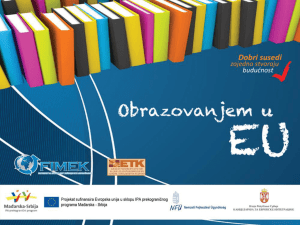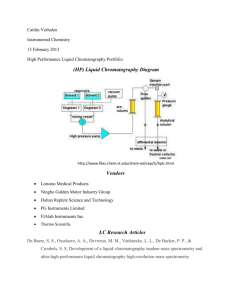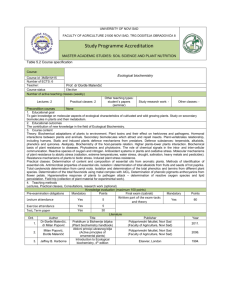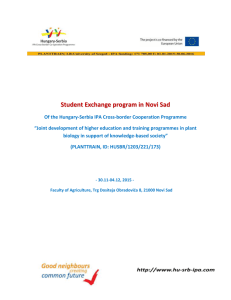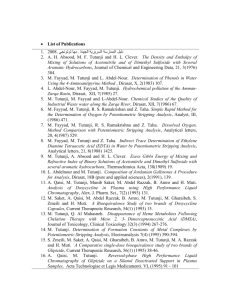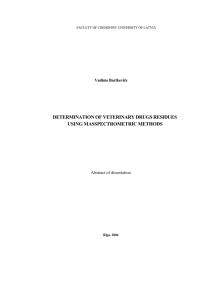Course: Feed quality control Course id: 8MST1I24 Number of ECTS
advertisement
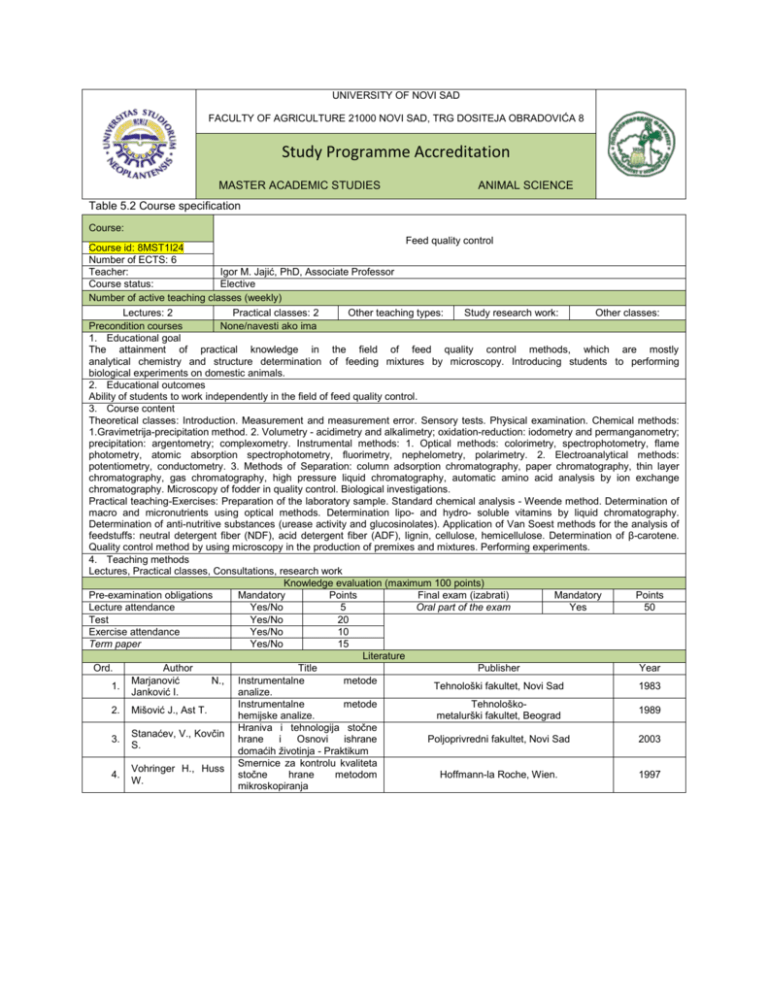
UNIVERSITY OF NOVI SAD FACULTY OF AGRICULTURE 21000 NOVI SAD, TRG DOSITEJA OBRADOVIĆA 8 Study Programme Accreditation MASTER ACADEMIC STUDIES ANIMAL SCIENCE Table 5.2 Course specification Course: Feed quality control Course id: 8MST1I24 Number of ECTS: 6 Teacher: Igor M. Jajić, PhD, Associate Professor Course status: Elective Number of active teaching classes (weekly) Lectures: 2 Practical classes: 2 Other teaching types: Study research work: Other classes: Precondition courses None/navesti ako ima 1. Educational goal The attainment of practical knowledge in the field of feed quality control methods, which are mostly analytical chemistry and structure determination of feeding mixtures by microscopy. Introducing students to performing biological experiments on domestic animals. 2. Educational outcomes Ability of students to work independently in the field of feed quality control. 3. Course content Theoretical classes: Introduction. Measurement and measurement error. Sensory tests. Physical examination. Chemical methods: 1.Gravimetrija-precipitation method. 2. Volumetry - acidimetry and alkalimetry; oxidation-reduction: iodometry and permanganometry; precipitation: argentometry; complexometry. Instrumental methods: 1. Optical methods: colorimetry, spectrophotometry, flame photometry, atomic absorption spectrophotometry, fluorimetry, nephelometry, polarimetry. 2. Electroanalytical methods: potentiometry, conductometry. 3. Methods of Separation: column adsorption chromatography, paper chromatography, thin layer chromatography, gas chromatography, high pressure liquid chromatography, automatic amino acid analysis by ion exchange chromatography. Microscopy of fodder in quality control. Biological investigations. Practical teaching-Exercises: Preparation of the laboratory sample. Standard chemical analysis - Weende method. Determination of macro and micronutrients using optical methods. Determination lipo- and hydro- soluble vitamins by liquid chromatography. Determination of anti-nutritive substances (urease activity and glucosinolates). Application of Van Soest methods for the analysis of feedstuffs: neutral detergent fiber (NDF), acid detergent fiber (ADF), lignin, cellulose, hemicellulose. Determination of β-carotene. Quality control method by using microscopy in the production of premixes and mixtures. Performing experiments. 4. Teaching methods Lectures, Practical classes, Consultations, research work Knowledge evaluation (maximum 100 points) Pre-examination obligations Mandatory Points Final exam (izabrati) Mandatory Points Lecture attendance Yes/No 5 Oral part of the exam Yes 50 Test Yes/No 20 Exercise attendance Yes/No 10 Term paper Yes/No 15 Literature Ord. Author Title Publisher Year Marjanović N., Instrumentalne metode 1. Tehnološki fakultet, Novi Sad 1983 Janković I. analize. Instrumentalne metode Tehnološko2. Mišović J., Ast T. 1989 hemijske analize. metalurški fakultet, Beograd Hraniva i tehnologija stočne Stanaćev, V., Kovčin 3. hrane i Osnovi ishrane Poljoprivredni fakultet, Novi Sad 2003 S. domaćih životinja - Praktikum Smernice za kontrolu kvaliteta Vohringer H., Huss 4. stočne hrane metodom Hoffmann-la Roche, Wien. 1997 W. mikroskopiranja



